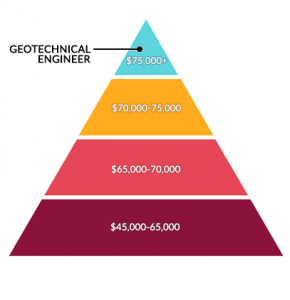Geotheta Fundamentals Explained
Geotheta Fundamentals Explained
Blog Article
Facts About Geotheta Revealed
Table of Contents8 Simple Techniques For Geotheta5 Simple Techniques For GeothetaUnknown Facts About Geotheta10 Simple Techniques For Geotheta3 Easy Facts About Geotheta Described

They conduct site examinations, gather samples, execute laboratory tests, and analyze information to review the suitability of the ground for building tasks - Geotechnical Engineers. Based on their findings, geotechnical designers give recommendations for foundation design, slope security, keeping structures, and mitigation of geotechnical threats. They work together with various other experts, such as engineers, architectural designers, and building groups, to make sure that geotechnical factors to consider are incorporated right into the general project style and application
By analyzing the behavior and properties of soil and rock, they can recognize possible geotechnical hazards such as landslides, soil negotiation, or slope instability. Their knowledge assists avoid failings or crashes that might threaten lives and residential property. Right here are some thorough duties and obligations of a geotechnical engineer: Site Investigation: Geotechnical designers conduct site examinations to gather information on subsurface conditions.
They interpret the information to comprehend the properties and actions of the soil and rock, including their strength, leaks in the structure, compaction characteristics, and groundwater problems. Geotechnical Analysis and Style: Geotechnical engineers examine the data accumulated during site investigations to examine the stability and suitability of the site for construction jobs. They carry out geotechnical estimations and modeling to review variables such as bearing capability, settlement, incline security, lateral earth pressures, and groundwater circulation.
Our Geotheta Statements
Structure Design: Geotechnical engineers play an essential duty in creating structures that can securely sustain the designated framework. They evaluate the dirt conditions and tons needs to determine the suitable structure type, such as shallow foundations (e.g., footings), deep structures (e.g (https://www.huntingnet.com/forum/members/geotheta.html)., stacks), or specialized methods like soil improvement. They think about aspects such as settlement limitations, birthing capability, and soil-structure interaction to create optimal foundation designs
They examine construction plans, display site tasks, and perform area examinations to confirm that the style recommendations are complied with. If unpredicted geotechnical problems emerge, they examine the situation and give recommendations for remediation or modifications to the style. Risk Analysis and Reduction: Geotechnical designers analyze geotechnical hazards and risks connected with the task site, such as landslides, liquefaction, or dirt disintegration.

Collaboration and Communication: Geotechnical designers function very closely with various other specialists associated with a job, such as architects, structural engineers, and building groups. Effective interaction and partnership are important to integrate geotechnical considerations right into the total task style and building and construction process. Geotechnical designers offer technical knowledge, answer inquiries, and make certain that geotechnical needs are satisfied.
The Facts About Geotheta Uncovered
Below are some kinds of geotechnical engineers: Structure Designer: Foundation engineers focus on developing and analyzing foundations for frameworks. They evaluate the soil conditions, tons requirements, and website features to determine the most ideal structure type and design, such as superficial structures, deep structures, or specialized techniques like heap foundations.
They assess the variables influencing slope stability, such as soil residential properties, groundwater problems, and incline geometry, and establish techniques to stop slope failings and reduce threats. Quake Engineer: Earthquake engineers specialize in assessing and making structures to hold up against seismic pressures. They analyze the seismic danger of a website, review soil liquefaction capacity, and establish seismic design requirements to make sure the safety and strength of structures throughout earthquakes.
They do area testing, gather examples, and analyze the collected data to characterize the soil homes, geologic developments, and groundwater problems at a website. Geotechnical Instrumentation Designer: Geotechnical instrumentation designers concentrate on tracking and gauging the habits of dirt, rock, and frameworks. They set up and preserve instrumentation systems that keep an eye on variables such as dirt negotiation, groundwater levels, slope motions, and architectural displacements to assess performance and offer very early warnings of prospective concerns.
The Single Strategy To Use For Geotheta
They conduct tests such as triaxial examinations, debt consolidation tests, straight shear examinations, and leaks in the structure tests to gather data for geotechnical evaluation and layout. Geosynthetics Engineer: Geosynthetics designers concentrate on the layout and application of geosynthetic materials, such as geotextiles, geogrids, and geomembranes. They make use of these products to improve dirt security, strengthen slopes, provide drainage remedies, and control erosion.
They often tend to be investigative individuals, which implies they're intellectual, introspective, and analytical. They are curious, systematic, sensible, logical, and sensible. Some of them are likewise social, use this link suggesting they're kind, generous, participating, individual, caring, practical, understanding, tactful, and friendly - Tailings Engineer.
In the office setting, geotechnical engineers make use of specialized software devices to do estimations, create designs, and evaluate data. They prepare reports, testimonial task specs, communicate with clients and employee, and coordinate task activities. The office setting supplies a favorable atmosphere for research study, evaluation, and collaboration with various other specialists associated with the project.
The Geotheta Ideas
They regularly check out project sites to perform site investigations, examine geotechnical conditions, and gather information for evaluation. These gos to involve taking a trip to various places, sometimes in remote or tough terrains. Geotechnical engineers might execute dirt tasting, conduct examinations, and display building and construction tasks to guarantee that the geotechnical facets of the job are being implemented correctly.
Geotechnical designers also function in specialized geotechnical laboratories. In these facilities, they perform experiments, do tests on dirt and rock examples, and assess the engineering buildings of the materials. Geotechnical research laboratory designers work extensively in these environments, taking care of screening tools, operating instruments, and recording data. They team up with other lab staff to guarantee accurate and dependable testing outcomes.
Report this page